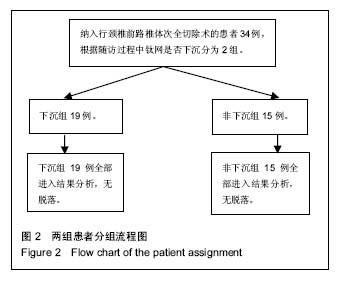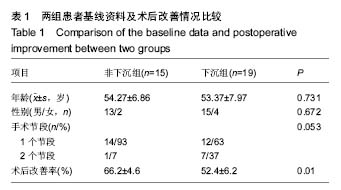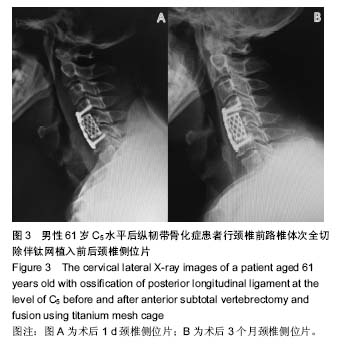| [1] Majd ME, Vadhva M, Holt RT. Anterior cervical reconstruction using titanium cages with anterior plating. Spine. 1999;24(15): 1604-1610.[2] Eck KR, Bridwell KH, Ungacta FF, et al. Analysis of titanium mesh cages in adults with minimum two-year follow-up. Spine. 2000; 25(18):2407.[3] Riew K, Rhee J. The use of titanium mesh cages in the cervical spine. Clin Orthop Relat Res. 2002;394(394):47-54.[4] Chuang HC, Cho DY, Chang CS, et al. Efficacy and safety of the use of titanium mesh cages and anterior cervical plates for interbody fusion after anterior cervical corpectomy. Surg Neurol. 2006;65(5):464-471.[5] Shams S, Rashid MJ. Anterior cervical reconstruction using titanium mesh cages. J Ayub Med Coll Abbottabad. 2007; 19(1): 23-25.[6] Bilbao G, Duart M, Aurrecoechea JJ, et al. Surgical results and complications in a series of 71 consecutive cervical spondylotic corpectomies. Acta Neurochirurgica. 2010; 152(7):1155-1163.[7] Lee SH, Sung JK. Anterior cervical stabilization using a semi-constrained cervical plate and titanium mesh cage for single level corpectomy. J Clin Neurosci. 2008;15(11): 1227-1234. [8] Chen Y, Chen D, Guo Y, et al. Subsidence of titanium mesh cage: a study based on 300 cases. J Spinal Disord Tech. 2008;21(7):489-492.[9] Hasegawa K, Abe M, Washio T, et al. An experimental study on the interface strength between titanium mesh cage and vertebra in reference to vertebral bone mineral density. Spine. 2001;26(8):957-963.[10] Dorai Z, Morgan HC. Titanium cage reconstruction after cervical corpectomy. J Neurosurgery. 2003;99(1 Suppl):3.[11] Narotam PK, Pauley SM, McGinn GJ. Titanium mesh cages for cervical spine stabilization after corpectomy: a clinical and radiological study. J Neurosurgery. 2003;99(2 Suppl):172.[12] Hee HT, Majd ME, Holt RT, et al. Complications of multilevel cervical corpectomies and reconstruction with titanium cages and anterior plating. J Spinal Disord Tech. 2003;16(1):1-8; discussion 8-9.[13] Van Jonbergen HP, Spruit M, Anderson PG, et al. Anterior cervical interbody fusion with a titanium box cage: early radiological assessment of fusion and subsidence. Spine J. 2005;5(6):645-649.[14] 张一龙,周非非,孙宇,等. 脊髓型颈椎病手术治疗后的近中期JOA评分变化规律[J]. 中国脊柱脊髓杂志, 2015, 25(1):13-17.[15] 郭永飞,陈德玉,陈宇,等. 颈前路术后钛网下沉对颈椎曲度和手术疗效的影响[J]. 中国骨与关节损伤杂志, 2006, 21(9):681- 683.[16] 邵建立,李志忠,王晶,等. 颈前路椎体次全切除钛网植骨锁定钢板内固定术用于脊髓型颈椎病的疗效分析[J]. 南方医科大学学报, 2009, 29(6):1226-1228.[17] 何仿,林昊,周涛,等. 颈前路钛网植骨融合术后早期内固定松动原因分析[J]. 中国矫形外科杂志, 2013,21(22):2320-2322.[18] 彭立军,羊明智,刘骞,等.颈椎前路椎体次全切除术后钛网下沉的原因分析[J]. 颈腰痛杂志, 2016,37(3):210-213.[19] 王俊波,王文军,刘进才,等. 颈椎术后钛网沉陷的影像学表现及相关影响因素[J]. 中南医学科学杂志,2014,42(1):66-69.[20] 苏再发,吴培增,王芳泰,等. 终板切除对终板-钛网界面应力分布影响的三维有限元分析[J]. 骨科, 2011,2(1):9-12.[21] 朱希田,田野,王以朋,等. 三种植骨融合方法在颈前路椎体次全切除术后维持椎间高度的影像学结果分析[J]. 中华外科杂志, 2012,50(11):981-986.[22] 陈宏,卢一生,张志敬,等. 颈前路椎体次全切除端盖与无端盖钛网植骨钢板内固定术治疗脊髓型颈椎病比较研究[J]. 颈腰痛杂志, 2016, 37(6):474-478.[23] 何磊,钱宇,金以军,等. 终板环在颈椎前路椎体次全切除植骨融合术中防止钛网沉陷的临床价值[J]. 中国骨伤,2014, 27(9): 738-744.[24] Wang LS, Wang XJ, Wang WJ, et al. Design, biomechanical study, and clinical application of a new pterygo-shaped titanium mesh cage. Eur J Orthop Surg Traumatol. 2012; 22(2):111-117.[25] 汪向东,王文军,王麓山,等. 自制颈椎翼型钛网的生物力学评价[J]. 中南医学科学杂志, 2013,41(3):280-282.[26] 王麓山,王文军,李超,等. 新型颈前路翼形钛网三维有限元分析[J]. 中国骨科临床与基础研究杂志, 2011,3(1):27-29.[27] 王文军,汪向东,朱一平,等. 新型翼形钛网在颈椎病手术治疗中的初步临床应用[J].中国矫形外科杂志, 2007,15(15):1126- 1128.[28] 舒冬平. 新型颈前路翼形钛网三维有限元分析[D]. 南华大学, 2014.[29] 申超. 颈前路解剖型翼形钛网的研制及生物力学研究[D]. 南华大学, 2014.[30] Yu F, Miao J, Liao X, et al. Evaluation of a new type of titanium mesh cage versus the traditional titanium mesh cage for single-level, anterior cervical corpectomy and fusion. Eur Spine J. 2013;22(12):2891-2896.[31] 黄平. 颈椎前路椎体次全切减压全接触钛网植骨融合的生物力学分析[D]. 第二军医大学, 2009.[32] 马跃. 新型颈椎植骨重建钛网的临床及影像学评价[D]. 第二军医大学, 2011.[33] 马立敏, 张余, 周烨,等. 3D打印技术辅助颈椎高位多节段脊索瘤手术临床应用[J]. 中国数字医学, 2014, 9(6):67-70.[34] 谷守欣, 李克. 3D打印技术在骨骼病变的应用进展[J]. 中国医学计算机成像杂志, 2015, 21(4):387-392.[35] 蒋明辉, 蔡立宏, 雷青,等. 3D打印技术在骨科临床的应用研究及展望[J]. 中华损伤与修复杂志:电子版, 2016, 11(4):288-290.[36] 张帆, 黄轩, 李凤宁,等. 3D打印技术制备个体化终板匹配颈椎间融合器的初步尝试[J]. 第二军医大学学报, 2015, 36(7): 782-785.[37] 钱文彬,杨欣建,蓝涛,等. 3D技术打印椎体在全脊椎整块切除术中应用的初步探索[J]. 生物骨科材料与临床研究, 2015, 12(2): 9-11.[38] 白郁. 德国完成首次3D打印钛脊柱融合植入手术[J]. 中国钛业, 2015,(2):21-22.[39] 鲍立杰, 张志平, 吴培斌. 3D打印技术在骨科的研究及应用进展[J]. 中国矫形外科杂志, 2015, 23(4):325-327. |
.jpg)



.jpg)
.jpg)